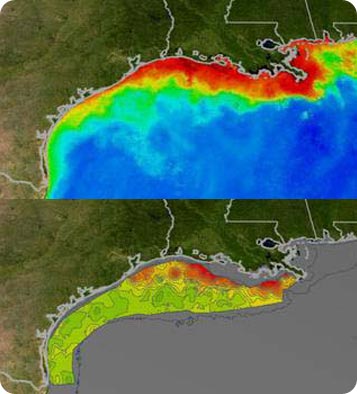Ethanol is a plant-based fuel that’s supposed to help reduce the world’s dependence on oil and cut down on greenhouse gases in the air. And in the United States, it’s caught on big. At the end of last year, monthly production was triple the rate of just five years earlier.
 Summer phytoplankton conditions and dissolved oxygen along the Gulf Coast. Red areas indicate high phytoplankton concentrations (top image) followed by low dissolved oxygen (bottom). Credit: NASA/data NOAA
Summer phytoplankton conditions and dissolved oxygen along the Gulf Coast. Red areas indicate high phytoplankton concentrations (top image) followed by low dissolved oxygen (bottom). Credit: NASA/data NOAABut while ethanol may help keep the air cleaner, there’s concern that it could increase the size of the dead zone in the Gulf of Mexico.
The dead zone appears every spring and summer. Nutrient-rich water from the Mississippi River leads to an explosion of phytoplankton -- tiny plants that are the first link in the food chain. That leads to an explosion of bacteria and other organisms that eat phytoplankton. These other organisms consume more of the oxygen in the water, leaving less oxygen for fish and shellfish, which either flee or die.
Most ethanol is made from corn, and corn production has skyrocketed to meet the demand. But corn requires a lot of fertilizer, some of which eventually washes into the Gulf. The fertilizers feed big blooms of algae, which increase the size of the dead zone.
So bigger corn crops could lead to a bigger dead zone. Last year’s was the third-largest since scientists began keeping records a quarter-century ago -- it covered almost 8,000 square miles.
Several steps could alleviate the problem, such as making ethanol from crops that need less fertilizer.
Without these or other steps, a fuel that’s designed to help the environment could harm it instead.

